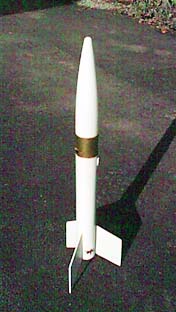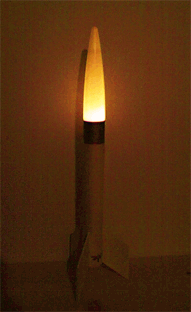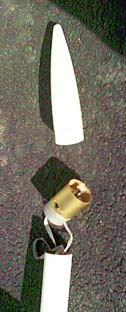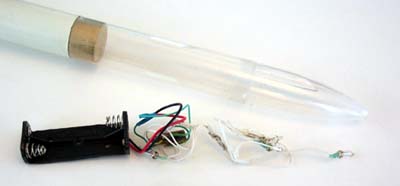
a website for
those who got back into model rocketry as adults
BORN
AGAIN ROCKETEER
home
night rocketry
I've always been interested in flying rockets at night. I like to come up with new lighting systems. In my youth, I built a whole series of these rockets, with all different illumination schemes. I still have the last one, which I named "Firefly 6". A transluminescent BT-60 nose cone serves as the main locator beacon. Two size N nicads power the incandescent bulb inside the nose. It also has a green LED near the back end of the body tube, which forms part of the firefly logo. Originally the LED was powered by its own button cell. The engine hook acted as a switch to turn it on momentarily during engine installation. After the rebuild, the LED is a blinking one that recieves power from the main battery via contacts in the front of the body tube. It stays on until parachute ejection.



In the past, I have built several night-launch rockets with built-in wiring, but then I read about someone flying a Nova payloader with a glowstick in it, and that got me thinking about a more flexible approach. I used parts from an Estes Phantom for this model. It has a clear payload bay that can receive a variety of lighting systems, in this case a flashing incandescent string taken out of a toy.
Originally I had some tiny LED lights shining down into the fin unit, but they were quite dim and added to the complexity of the model, so I removed them, and now there is no built-in wiring. It had been tricky to fit a button cell and lights into the small space between the motor tube and the outer body tube. In retrospect, I could have located some brighter LEDs that size, but at the time I was just using what I had on hand. Anyway, when I took the lights out, I shortened the body tube, and I think the proportions look nicer this way.


For the Quest Saucer I simply taped some LED lights onto the model. Shulman Aviation sells these little LED lights with built-in batteries. They can be attached to any rocket to provide some little navigation lighs. I was surprised at how neat this looked on the way up. The tiny points of light are very realistic-looking. Since the Saucer doesn't go very high, visibility is no problem, and no other lights are needed. (I even forgot to turn the lights on once and still had a successful recovery.)

By the way, the Quest C6-0 has a much longer burn, giving nicer flights than the Estes C6-0 in this type of model.